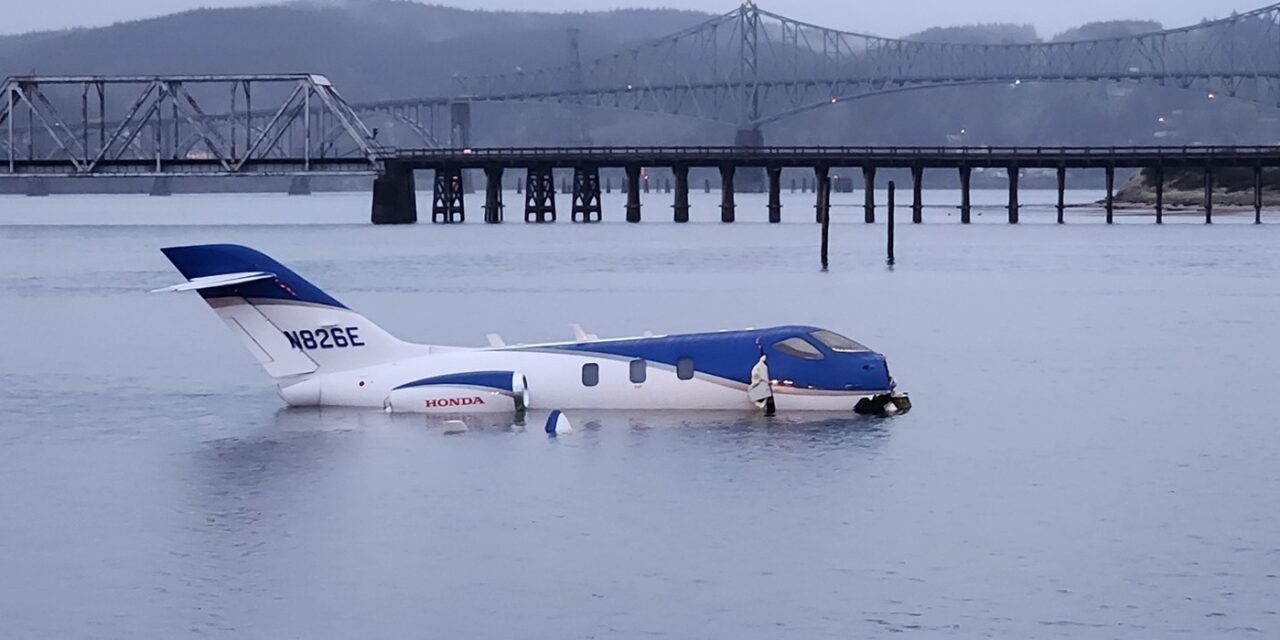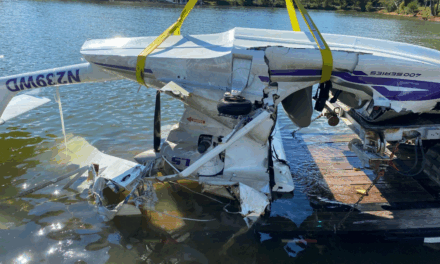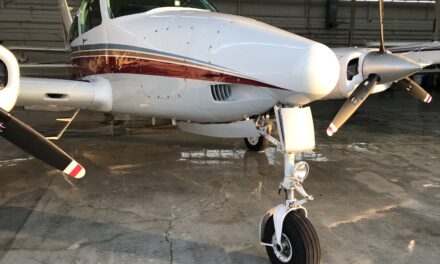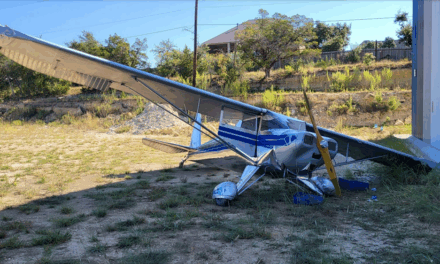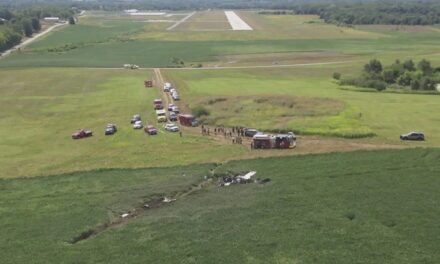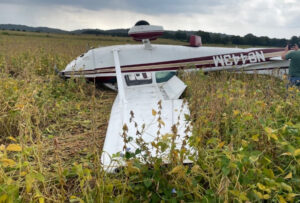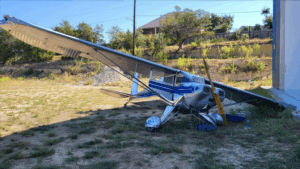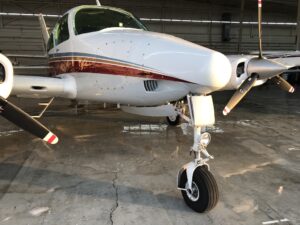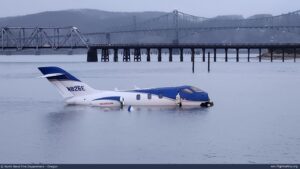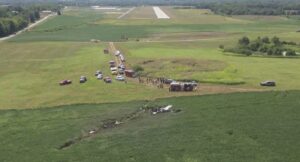On April 7, 2025, the HondaJet N826E runway overrun into Coos Bay became one of the most talked-about business jet incidents of the year. During landing at Southwest Oregon Regional Airport (OTH), the HA-420 failed to stop, skidded off the runway, and came to rest in shallow water off Coos Bay. All five aboard—one pilot and four passengers—survived with minor injuries. In the hours that followed, aviation media, safety analysts, and HondaJet operators pored over the preliminary findings for lessons. (Coos County Airport District, NTSB) NTSB preliminary findings
A Jet Built for Efficiency Meets Challenging Conditions
The focus keyphrase: HondaJet N826E runway overrun represents both an aircraft and an event that clash hope and reality. Registered as N826E, the Honda HA-420 is a light business jet known for its sleek design, over-wing engine mounts, and strong dispatch reliability. Its community praises its innovation and fuel efficiency, two traits that make this overrun particularly jarring. (Wikipedia HondaJet) HondaJet HA-420 specs
N826E departed St. George, Utah, at 05:07 a.m. under IFR. Its destination: OTH in North Bend, Oregon. By all accounts, the inbound route was uneventful. When it launched its final approach to Runway 05, the conditions were damp—recent rain had left parts of the pavement wet. Early touchdown seemed reasonable, but braking effectiveness degraded as rollout progressed. (Coos County preliminary findings)
The Overrun and the Water Incursion
As the HondaJet decelerated, braking performance slipped. No skid marks appeared on the runway, suggesting anti-skid systems did not lock the wheels. The pilot steered right to avoid a localizer antenna, then crossed pavement limits into grassy overrun terrain. The jet descended a 15-foot embankment and finally rested in about five feet of water in Coos Bay—roughly 100 feet past the runway’s end. (Coos County preliminary disclosure)
The aircraft sustained structural damage to its fuselage and wings, but no fire ensued. Recovery required a barge and crane, operations conducted under NTSB supervision. (AeroTime article) AeroTime coverage
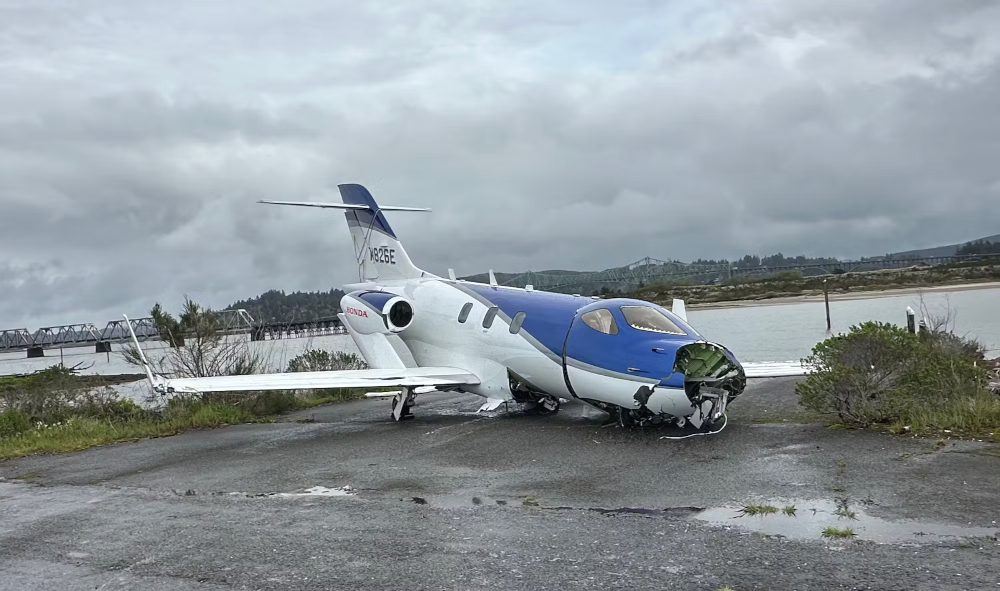
Key Technical and Performance Factors
Investigators have offered several clues about what went wrong:
- Diminished Braking Effectiveness: The pilot reported that braking “diminished” during rollout, despite initial braking appearing normal. No component showed preimpact failure. (Coos County news release)
- Wet Runway Conditions: The pavement had residual moisture from earlier precipitation. This, coupled with temperature and jet weight (~9,000 lbs), pushed the required stopping distance near limits. (Coos County findings)
- No Thrust Reversal or Spoilers: The HA-420 is not equipped with thrust reversers or spoilers. It does utilize a speed brake. Slower deceleration under adverse conditions is a known limitation. (Preliminary report)
- Landing Distance Margins: The calculated landing distance required for wet conditions and Vref speed approached ~5,910 feet, leaving little room for error. (Preliminary disclosure)
- Braking & Anti-Skid Systems: While no mechanical anomalies were found, the absence of skid markings suggests the anti-skid or braking system may have transitioned to reduced effectiveness during rollout under load.
These dynamics echo earlier HondaJet overruns, including a recent one in Florida involving a Jet It aircraft. (AIN Online) HondaJet overrun trend
Community Reaction & Industry Take
The aviation world responded swiftly. AIN Online flagged this as part of a troubling pattern for HondaJet operators. Despite being a modern, well-supported jetline, runway excursions are becoming a recurring theme. (AIN coverage)
Operators and business jet forums debated pilot technique, software update status, and whether Honda’s safety training and margin guidance are sufficient. Some questioned whether this model pushed performance margins too aggressively for wet runway operations.
Local media in Oregon focused on the dramatic visuals of a jet in the bay, rescue efforts, and temporary airport disruption. NBC5 / KOBI5 reported one passenger with serious injury, though most were treated and released. (KOBI5) Local media report
Broader Lessons & Recommendations
From the HondaJet N826E runway overrun, several lessons stand out:
- Operators must assume degraded braking when runway surfaces are damp—even if wet lines look dry.
- Delay touchdown beyond the threshold only when absolutely necessary; early braking helps maximize safe stopping room.
- Leverage full deceleration means (autobrakes, speed brakes, wheel braking) early in rollout.
- Simulators and training should incorporate wet-runway overrun scenarios to reinforce conservative margins.
- Consider active runway overrun alerting systems or performance monitoring sensors that warn pilots in real time if stopping distance margins shrink below safe thresholds.
Reflections & Outlook
The HondaJet overrun to water is a stark reminder that even advanced light jets are vulnerable at the runway’s margins. Today’s designs aim to minimize risk, but real-world operations—weather, runway condition, pilot judgment—always test those limits.
In this case, the survival of all aboard is cause for relief. But the damage and the public attention demand scrutiny, change, and humility. Business aviation—and especially light jet operations—must continually reassess safety margins and engineering assumptions.
As business jets become faster and lighter, should regulatory bodies mandate built-in overrun detection or alerting systems even for certified aircraft to prevent incidents like HondaJet N826E’s excursion?

